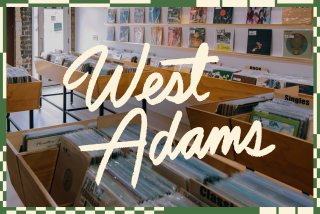PHOTO REVIEW : Two Masters: So Alike, Yet So Different : Works on exhibit at Museum of Photographic Arts in Balboa Park highlight the genius of both Ansel Adams and Paul Strand, friends from the early ‘30s.
- Share via
SAN DIEGO — Ansel Adams was a naturalist; Paul Strand a populist. Adams looked for the ravaged young tree to mark the incidental passage of time in the forest; Strand looked to an abandoned cluster of bicycles in the woods. Two such images in the stunning exhibition “Paul Strand and Ansel Adams: Native Land and Natural Scene,” at the Museum of Photographic Arts in Balboa Park, point out the similarities and differences between these two great masters of 20th-Century American photography. The two were friends from 1930 until Strand died in 1976.
Both artists made stunningly pristine pictures, in which every minor detail in the composition counts. Both moved outside the urban environment to seek out a more primitive, romantic, and--in the artists’ view--more natural vision of the world. But, although they sometimes went to the same kinds of natural environs to find pictures, Adams, who died in 1984, mostly shunned the traces of human beings, focusing instead on the majestic details of nature--from the small droplets of water frozen on the smallest branches of a tree, to the enormous majestic sequoias in Yosemite National Park.
Strand more often looked for signs of his fellow man, in his long career of travels to Mexico, Europe and Africa, as well as in his many photographs of the American heartland.
The Strand/Adams show, is designed to show the overlaps in the photographic tactics of these two great photographers who were first introduced in Taos in 1930, a meeting that made Adams decide to turn from his ambition to be a musician and become a photographer instead.
The show also serves as a refresher course on the two artists--particularly useful in the case of Strand, whose work has not been seen here much in recent years. A refresher course is not really needed for Adams, however, whose work has been remembered in three major exhibitions in San Diego in the past few years, most recently in March at the Mandeville Gallery at UC San Diego.
One is tempted to say “Enough!” to Adams, whose clear-visioned views of the American landscape are so beautiful and so perfect that they have become somewhat boring. But, in this context, one sees the work anew, freshened by the comparison with Strand, whose moody, almost confrontational portraits of peasants and working folks are vivid illustrations of the artist’s political nature.
The show of 124 works is organized in four parts: an introduction to the early work of both artists, then a large section for each of the two, and, finally, a portion where the works are paired for composition and content.
Together, as is nearly always the case with visual juxtapositions, the two artists’ work enlighten us about the subtleties of their thought processes. The comparisons tend to highlight the differences as well as the similarities. And, often enough, the England-based guest curators Anne Hammond and Mike Weaver--who organized the show for the University of Arizona’s Center for Creative Photography--have selected perfect images as points of comparison.
Adams’ close-up image of a San Francisco grave marker is shown with a picture by Strand of a row of gravestones. Adams’ sharp-focus directs the eye toward the details on the stone--the erosion and wear-and-tear of time. Strand’s picture, by contrast, highlights the mystery of the scene: the graves are shown from a distance, too far to read. Both artists chose formal, geometric compositions--neither one enlightens us about the setting or the subjects, but the effect of each is very different. Adams’ eye is clinical, Strand’s emotional.
Two other pictures illustrate the same point: Strand’s “Old Fisherman,” 1936, shows a country fellow standing behind a thigh-high fence of chicken wire. Adams’ “Woman Behind Screen Door,” 1944, looks at the portrait of the aging woman through the tight mesh of the wire weave. In Strand’s work, the fence is seen as an attribute of the man’s life--a small incident that shows him to be in a rustic, rural setting. In the Adams, the screen is a formal device that illustrates the elusiveness of the woman. Hidden by the screen, we almost overlook her worn, wrinkled face. And, even before we see her for who she is--a worn-out woman in her later years--we look again at the details, the light and shadow on the screen.
A catalogue to the show is published in the Center for Creative Photography’s scholarly journal “The Archive,” and it reproduces the artists’ exchange of letters from 1933 to just before Strand died, including, even, some final notes written to Adams by Strand’s widow. The letters are somewhat typical of artists’ letters: comments on shows each has seen, comments on one another’s works. Most poignantly, they reveal Adams’ continuing reverence for Strand.
From the tone of his letters, Adams continued to see Strand as almost a hero for much of his life. Writing to Strand in 1968, he says “Every time I see a Strand I feel infinitely better about photography!”
Although Strand’s style did not really rub off on Adams--this show demonstrates that the direction of his glance may have had more effect than we would have thought. These two artist often looked at the same kinds of places to find their pictures.
What they found was just very different.
* “Paul Strand and Ansel Adams: Native Land and Natural Scene” continues at the Museum of Photographic Arts in Balboa Park through Aug. 25. Hours are 10 a.m. to 5 p.m. daily, Thursdays until 9 p.m.
More to Read
The biggest entertainment stories
Get our big stories about Hollywood, film, television, music, arts, culture and more right in your inbox as soon as they publish.
You may occasionally receive promotional content from the Los Angeles Times.










